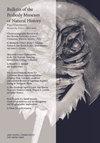Morphological Differentiation in White-Footed Mouse (Mammalia: Rodentia: Cricetidae: Peromyscus leucopus) Populations from the New York City Metropolitan Area
IF 0.9
4区 哲学
Q2 BIODIVERSITY CONSERVATION
引用次数: 8
Abstract
Abstract Genetic studies have shown that New York City white-footed mouse (Peromyscus leucopus) populations exhibit substantial genetic structure and high levels of allelic diversity and heterozygosity. These studies have also identified mutations and genes involved in the divergence of urban and rural P. leucopus populations. To investigate whether morphological change mirrors the genetic differentiation observed in New York City P. leucopus populations, we conducted univariate and multivariate analyses on 4 external and 14 skull variables to compare urban, suburban and rural P. leucopus populations from in and around New York City. The only significant morphological differences among the three populations were in upper and lower toothrow lengths, both of which had high loadings in our principal components analyses. In general, rural individuals were found to have longer upper and lower toothrows than urban ones. This difference is likely due to the relationship between food quality and size of dental occlusal surfaces. Generally, lowerquality food requires more chewing and its consumption is facilitated by larger occlusal surfaces. Our results suggest that urban mice consume a higher-quality diet or food that requires less chewing than their rural counterparts by making use of the availability of natural food sources in rich, vegetative understories characteristic of urban forest fragments. Our cluster analysis of the skull variables revealed that urban and suburban populations are more similar to one another than to the rural population.纽约大都市区白足鼠(哺乳目:啮齿目:蟋蟀科:白斑足鼠)种群的形态分化
摘要遗传学研究表明,纽约市白足鼠(Peromyscus leucopus)种群具有丰富的遗传结构和高水平的等位基因多样性和杂合性。这些研究还确定了与城市和农村白脓杆菌种群差异有关的突变和基因。为了研究形态变化是否反映了在纽约市白暨豚种群中观察到的遗传分化,我们对4个外部和14个头骨变量进行了单变量和多变量分析,以比较纽约市及其周边地区的城市、郊区和农村白暨豚群体。三个种群之间唯一显著的形态差异是上齿列和下齿列的长度,在我们的主成分分析中,这两个种群都具有高负荷。一般来说,农村个体的上齿和下齿比城市个体长。这种差异可能是由于食物质量和牙齿咬合面的大小之间的关系。一般来说,质量较低的食物需要更多的咀嚼,较大的咬合面有助于食物的消耗。我们的研究结果表明,通过利用城市森林碎片特有的丰富营养林下的天然食物来源,城市老鼠比农村老鼠消耗更高质量的饮食或需要更少咀嚼的食物。我们对头骨变量的聚类分析表明,城市和郊区人口彼此更相似,而不是农村人口。
本文章由计算机程序翻译,如有差异,请以英文原文为准。
求助全文
约1分钟内获得全文
求助全文
来源期刊

Bulletin of the Peabody Museum of Natural History
BIODIVERSITY CONSERVATION-ECOLOGY
CiteScore
2.40
自引率
0.00%
发文量
6
审稿时长
>12 weeks
期刊介绍:
The Bulletin of the Peabody Museum of Natural History publishes original research based on specimens, artifacts and related materials maintained in the collections of the Yale Peabody Museum of Natural History’s curatorial divisions. The Bulletin is published twice a year, in April and October.
 求助内容:
求助内容: 应助结果提醒方式:
应助结果提醒方式:


